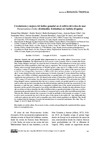Please use this identifier to cite or link to this item:
https://accedacris.ulpgc.es/jspui/handle/10553/72077
| Title: | Crecimiento y mejora del índice gonadal en el cultivo del erizo de mar Paracentrotus lividus (Echinoida: Echinidae) en Galicia (España) | Other Titles: | Growth rate and gonadal index improvement in sea urchin culture Paracentrotus lividus (Echinoida: Echinidae) | Authors: | Rey-Mendez, Manuel Touron, Noelia Rodriguez-Castro, Belen Rama-Villar, Antonio Fernandez-Silva, Iria González Henriquez, Nieves Martinez, Dorotea Ojea, Justa Luis Catoira, Jose |
UNESCO Clasification: | 2401 Biología animal (zoología) 251092 Acuicultura marina |
Keywords: | Strongylocentrotus-Droebachiensis Psammechinus-Miliaris Lamarck Echinodermata Evechinus-Chloroticus Reproductive-Cycle, et al |
Issue Date: | 2015 | Journal: | Revista de Biologia Tropical | Abstract: | The high demand for Paracentrotus lividus (Lamarck, 1816) in countries like France, Italy, Turkey, Belgium and Japan, has raised the level of extraction of this echinoderm in recent years and has generated wear urchin populations, which take years to regenerate. The economic importance of P. lividus in Galicia, with an average annual production of 700 <= 000 kg and a value close to (sic) 2 million in 2013, has led us to perform a variety of experiences in order to analyze the possibilities of the culture of this species in Galicia in raft. We have designed three experiences: 1) Effect of five diets and three densities on the growth of juvenile P. lividus obtained from the natural environment; 2) Growth of juvenile P. lividus obtained from hatchery, fed algae, and 3) Effect of different experimental diets on gonadal index of P. lividus commercial size. The experiments were performed on a USC raft situated in the estuary of Muros-Noia (Galicia) for four years (2007-2010), using 2 231 total urchins, from the natural environment (450), hatchery (773) and market size (1 008), being designed various experimental diets that try to increase somatic and gonadal growth in sea urchins, in order to reduce the rise time of juveniles from the wild and hatchery until they reach the size commercial (55 mm diameter), or until they get a suitable size to repopulate overfished areas of the natural environment (20 mm diameter), and the growth of the gonads of sea urchins with different diets. Monthly has taken diameter of juvenile sea urchins in order to determine the effect of different diets on growth and densities of the same, as well as determining the gonadal index (GI) in sea urchins of commercial size to see the effect took different tested diets. With the data obtained estimates that, at present, it would be profitable to feed juvenile sea urchins P. lividus in raft to reach commercial size, due to the low price of this species in the market (3(sic) / kg). Additonally they could reach optimum size and be used to repopulate areas where natural populations are depleted. This should be combined with the fattening of gonads and extended time of commercial exploitation. | URI: | https://accedacris.ulpgc.es/handle/10553/72077 | ISSN: | 0034-7744 | DOI: | 10.15517/rbt.v63i2.23161 | Source: | Revista De Biologia Tropical [ISSN 0034-7744], v. 63 sup. 2, p. 261-272, (Junio 2015) |
| Appears in Collections: | Artículos |
SCOPUSTM
Citations
5
checked on Jun 8, 2025
WEB OF SCIENCETM
Citations
4
checked on Feb 25, 2024
Page view(s)
78
checked on May 18, 2024
Download(s)
14
checked on May 18, 2024
Google ScholarTM
Check
Altmetric
Share
Export metadata
Items in accedaCRIS are protected by copyright, with all rights reserved, unless otherwise indicated.
